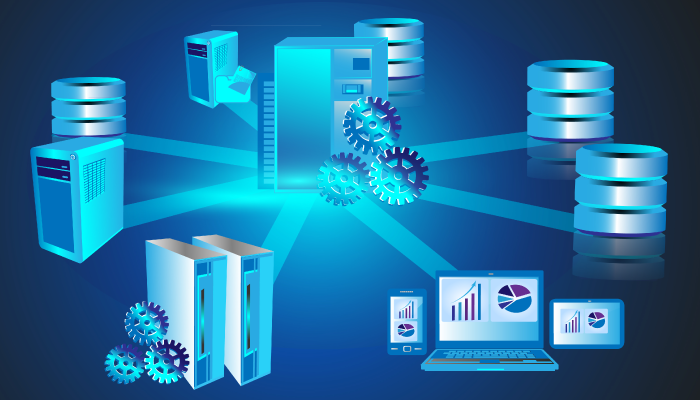
The Future of Database Management: Trends, Challenges, and Innovations
Introduction to Database Management
In the rapidly evolving world of technology, Database Management Systems (DBMS) play a vital role in storing, managing, and retrieving data efficiently. They serve as the backbone for virtually every modern software application, from enterprise-level systems to web applications. A database is an organized collection of structured information, typically stored electronically, which is easily accessible, manageable, and updated. As businesses and organizations increasingly rely on data to make informed decisions, the demand for effective database management becomes ever more critical.

Key Concepts in Database Management
1. Data: Data is raw, unorganized facts that need to be processed. In a database, data is stored in the form of records, and each record can have multiple fields. A DBMS organizes this data efficiently to allow easy access and manipulation.
2. Database Schema: A schema defines the structure of a database. It outlines how data is organized and defines the relationships between different pieces of data. The schema acts as a blueprint for designing the database.
3. Tables, Rows, and Columns: Databases are typically structured as tables, where rows represent individual records, and columns represent the attributes of each record. For example, a customer database might have a table where each row corresponds to a customer, and each column represents attributes like name, email, and phone number.
4. Primary Key and Foreign Key: A primary key uniquely identifies each record in a table. It ensures that there are no duplicate records. A foreign key, on the other hand, is a field in one table that refers to the primary key in another table, establishing a relationship between the two tables.
5. Relationships: In a relational database, relationships can be one-to-one, one-to-many, or many-to-many. These relationships determine how data in different tables is connected and how it can be queried.
Types of Database Management Systems
1. Relational Database Management System (RDBMS): RDBMS is the most widely used type of DBMS. It organizes data into tables and allows users to create, read, update, and delete (CRUD) operations on the data. The relational model is based on mathematical set theory, and Structured Query Language (SQL) is typically used to interact with RDBMS. examples are MySQL, PostgreSQL, Microsoft SQL Server, Oracle Database.
2. NoSQL Database: NoSQL databases are designed to handle large volumes of unstructured data. Unlike relational databases, NoSQL databases do not rely on a fixed schema, making them more flexible for applications that need to store dynamic or semi-structured data. types are : Document-based databases, Key-value stores, Column-family stores, Graph databases
3. Object-oriented Database Management System (OODBMS): OODBMS stores data in the form of objects, which is similar to how data is handled in object-oriented programming languages. This makes OODBMS particularly suitable for applications that require complex data models, such as multimedia systems, engineering designs, and scientific simulations.
4. Hierarchical Database Management System (HDBMS): In a hierarchical database, data is organized in a tree-like structure, where each record has a parent-child relationship. This type of DBMS is ideal for applications with data that has a hierarchical nature, such as an organizational structure.
5. Network Database Management System (NDBMS): NDBMS is similar to HDBMS but allows more complex relationships by letting records have multiple parent and child relationships. This flexibility is suitable for applications where complex interrelations between data elements exist.
Components of a Database Management System
- Database Engine

- Database Schema
- Query Processor
- Transaction Manager
- Data Dictionary
Advantages of Database Management Systems
- Data Integrity and Security: A DBMS ensures that data remains accurate and consistent by enforcing constraints such as primary keys and foreign keys. It also allows fine-grained access control, so only authorized users can view or modify certain data.
- Data Redundancy and Consistency: By centralizing data storage, a DBMS eliminates unnecessary data duplication, ensuring that updates to data are reflected across all systems. This reduces the risk of inconsistencies. Data Sharing and Accessibility
- Data Sharing and Accessibility: A DBMS allows multiple users to access and manipulate data concurrently, making collaboration more efficient. It also provides tools for managing concurrent access without compromising data integrity.
- Backup and Recovery: Most DBMS systems offer automated backup and recovery features, ensuring that data can be restored in case of hardware failure, power outages, or other unforeseen events.
- Scalability: Modern DBMS can handle increasing amounts of data and users as organizations grow. NoSQL databases, in particular, are designed to scale horizontally, adding more servers to handle higher volumes of data.
Challenges in Database Management
- Big Data Management: With the explosion of data generated by IoT devices, social media, and other sources, managing big data is a significant challenge. Traditional relational databases are often not equipped to handle the sheer volume of unstructured data, necessitating the use of NoSQL databases.
- Data Security and Privacy: As more data is stored digitally, the risk of data breaches and unauthorized access increases. Organizations must ensure that their DBMS includes robust security features, such as encryption, access control, and auditing, to protect sensitive data.
- Performance Optimization: As the amount of data grows, so does the complexity of managing it. Optimizing database performance requires balancing the needs for quick data retrieval, efficient storage, and fast query execution, especially when dealing with large, complex queries or massive datasets.
- Managing Multiple Database Systems: Many organizations use a combination of different types of databases (RDBMS, NoSQL, etc.) to handle various data needs. Managing multiple database systems can be challenging, especially in ensuring that data is consistent and synchronized across all systems.
- Data Integration: With data spread across multiple systems, integrating and unifying data can be a complex task. Organizations must often employ middleware solutions or custom integrations to ensure data from different sources can be combined and analyzed.
Emerging Trends and Innovations in Database Management
As technology evolves, so too does the field of database management. Several emerging trends are shaping the future of DBMS:
- Cloud-Based Databases: Cloud computing has transformed how data is stored and managed. Cloud-based databases offer flexibility, scalability, and reduced infrastructure costs. Many organizations are migrating their on-premise databases to cloud providers such as AWS, Microsoft Azure, and Google Cloud.
- Artificial Intelligence and Machine Learning Integration: AI and machine learning are increasingly being integrated with databases to improve performance and automate tasks like query optimization, anomaly detection, and predictive analytics. This trend is driving the development of "autonomous databases" that can self-tune and manage themselves with minimal human intervention.
- Multi-Model Databases: A multi-model database supports different types of data models (relational, document, graph, key-value) within a single system. This flexibility allows organizations to manage various kinds of data more efficiently without needing multiple database systems.
- Blockchain and Distributed Databases: Blockchain technology, which enables decentralized and tamper-proof databases, is gaining traction in industries such as finance, healthcare, and supply chain management. Distributed databases like blockchain provide higher levels of security and transparency, making them suitable for applications where data integrity is critical.
- In-Memory Databases: In-memory databases store data in the system's main memory (RAM) rather than on disk, enabling much faster data retrieval and query execution. These databases are particularly useful for real-time analytics and high-performance applications.
VCD Studio’s Database Management Services
At VCD Studio, we offer comprehensive database management services to help you organize, store, and retrieve your business data effectively. Our services are designed to meet the unique requirements of your business, ensuring that your database system supports your operations and enhances your performance
Conclusion
Database management is a critical component of modern computing, enabling organizations to store, manage, and access vast amounts of data efficiently. The variety of DBMS options, including relational, NoSQL, and cloud-based solutions, provides flexibility for managing different types of data. However, with this flexibility come challenges, such as big data management, security concerns, and performance optimization. As the field continues to evolve, emerging technologies like AI, blockchain, and cloud computing are reshaping the landscape of database management. The future promises even more innovative solutions, but it will also require continued diligence in addressing security, scalability, and integration challenges.

Leave a Comment